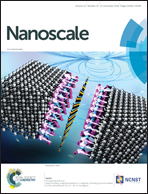Charge-governed phase manipulation of few-layer tellurium†
Abstract
Few-layer tellurium is an emerging quasi-one-dimensional layered material. The striking feature of Te is its presence as various few-layer allotropes (α–δ). Although these allotropes offer substantially different physical properties, only the α phase has been synthesized in neutral few-layers as it is so far the most stable few-layer form. Herein, we show that hole or electron doping could maintain a certain Te phase. The β, α, γ and δ phases appear as the most stable forms of Te bilayer, in sequence, with bandgap variations over 1 eV. In Te trilayer, a novel metallic chiral α + δ phase emerges, leading to the appearance of chirality. Transitions among these phases, understood at the wavefunction level, are accompanied by the emergence or elimination of inversion centers (α–β, α–γ, α–α + δ), structural anisotropy (α–γ, γ–δ) and chirality (α–α + δ), which could result in substantial changes in optical and other properties. In light of these findings, our work opens a new avenue for stabilizing different allotropes of layered materials; this is crucial for using their outstanding properties. This study also suggests the possibility of building mono-elemental electronic and optoelectronic heterostructures or devices, which are attractive for future applications in electronics.



 Please wait while we load your content...
Please wait while we load your content...